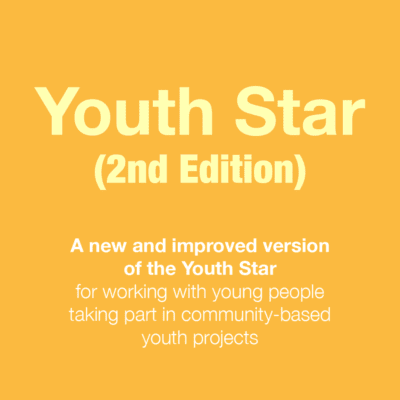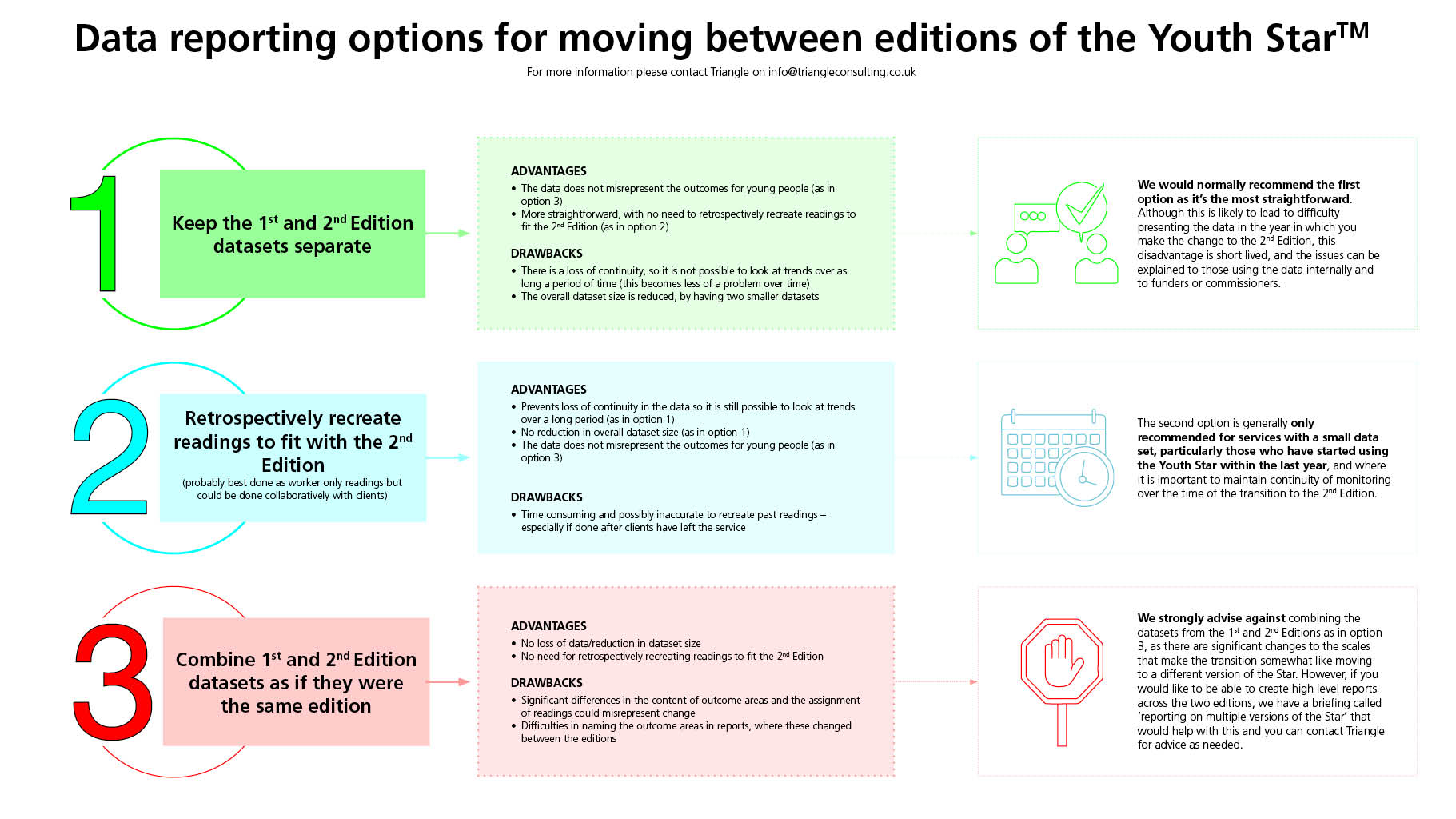1 Why a new Edition?
Triangle is responsible for ensuring that the Outcomes Stars stay relevant and are as good as possible; we keep them under review, seeking and analysing feedback and developing new editions as needed. We published the Youth Star in 2012 and since then have developed many more Stars for different sectors, leading to new learning, including how to make the Stars and guidance even more trauma-informed, strengths based and person-centred.
The 1st Edition of the Youth Star was published without detailed scale descriptions, so a key aim of developing a new edition was to develop detailed scales to support training, consistency and clarity. Further, Triangle has gathered feedback about the Youth Star and also about how the youth sector has changed and evolved, resulting in helpful feedback. This also pointed to a need to review this Star to make it as good a fit as possible for youth work today.
2 What has changed?
We have created detailed scale descriptions for the six areas covered by the Youth Star. These are in a new User Guide, along with a graphic of the short scale descriptions. The User Guide is most relevant as an important new resource for workers, in training and initial familiarisation with the Youth Star and for reference to ensure accurate and consistent completion of the Star. However, it is written in accessible language and can be shared with young people who are interested and able to engage with more detail.
There is more detail in the Development Report but in summary the main changes are:
- The first stage of the Journey of Change is renamed stuck, to recognise that things may feel or be stuck for a young person at that stage for many reasons, not necessarily because they are ‘not interested’, as the language in the 1st Edition implied. This also makes this wording consistent with other versions of the Outcomes Star
- The first scale is now Interests and activities (replacing ‘Making a difference’). This area still emphasises helping others, group activities and teamwork but is widened to recognise activities and interests such as sports, arts, music that are positive for young people but can be individual not group activities and not aimed at making a difference to others.
- Health and well-being replaces ‘Well-being’ as it now covers both a healthy lifestyle and emotional health, including managing physical or mental health conditions. It recognises that those who are younger may not have much control over their diet or other choices and that their family may not support living healthily.
- Education and work now emphasises getting the most out of school/ work rather than focusing on achievement. It was also widened to include training, apprenticeships or internships and to recognise the role of the school, college or workplace in providing extra support where needed, so it is not just up to the young person.
There are other minor tweaks to scales, with some aspects moving from one scale to another to increase clarity and accessibility and adding references to social media and staying safe online. In addition, we listened to feedback from young people and workers and changed some wording to be more sensitive, trauma-informed and responsive to the issues people faced and created flashcards and new guidance.
3 Should I move to the new edition?
We believe that the 2nd Edition of the Youth Star is better, and the additional resources will make it a more effective tool for supporting and measuring change with young people, so we recommend you do transition your service to the 2nd Edition. However, the 1st Edition will continue to be available for the foreseeable future, so you have a choice and time to decide.
The 2nd Edition of the Youth Star is available for those with a Star licence to access on the Star Online, so you can download and it and review the new resources for yourself to help make a decision.
4 What should I do to move the to the new, 2nd Edition?
If you already have Star licences, there is no extra cost to using the new edition and no requirement for additional training, though you may want to consider refresher training. Talk to Triangle about your current licencing and how to make the most of the transition to support good use of the Star.
Consider how you will introduce the new edition to practitioners, for example by finding ways to ensure that they familiarise themselves with the User Guide with detailed scales, changes in wording and other new resources, including the flashcards and updated guidance. This can be done through refresher training, supervision sessions, discussions in team meetings and by sharing and promoting the “introducing the new Youth Star 2nd Edition” poster for practitioners, available from the Star Online or Triangle.
You also need decide when and how to introduce the 2nd Edition. The main options are:
- Introduce the 2nd Edition for new clients and keep using the 1st Edition for existing clients who have already completed at least one Star. The advantage of this approach is that clients only have to engage with one version and their change shown from one reading to the next is valid because it is gathered using the same version
- Decide on a date from which to introduce the 2nd Edition with all clients, both new and existing. This is more straightforward for the service because than using both versions and makes the move more swiftly to the new edition. However, change measured from one reading to another is not valid and may be misleading if different editions are used with the same person (see data section below). This has implications for both keywork/ action planning with that individual and for the validity of the service’s Star data overall.
5 What about my Star data?
Because some of the Youth Star scales have significant changes and others have minor changes, data gathered using the 1st Edition will not be directly comparable to data gathered using the 2nd Edition. The most marked example is that someone actively and positively pursuing individual interests such as arts or sports, may be at 1 in the first scale of the 1st Edition (Making a difference) but could be at 5 in the 2nd Edition (Interests and activities). The other differences are summarised above and set out in more detail in the development report.
There are three main options for how to approach data and reporting when making the transition to the second edition of the Youth Star, as set out below




